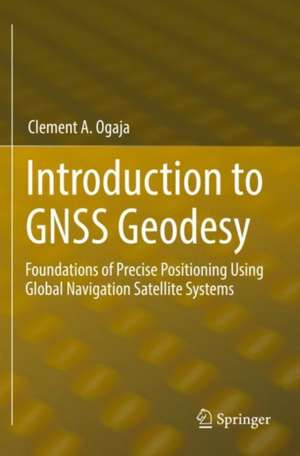Introduction to GNSS Geodesy: Foundations of Precise Positioning Using Global Navigation Satellite Systems
Autor Clement A. Ogajaen Limba Engleză Paperback – 27 mai 2023
Chapters 4 and 5 dig deep into mathematical formulation of GNSS parameter estimation and observation models. All the concepts are presented clearly and concisely, with diagrams to assist reader comprehension. Chapter 6 describes Continuously Operating Reference Station (CORS) networks and their role in geodesy and definition of reference frames. Various global and regional CORS networks are presented in this section. Th e chapter also covers GNSS data and common formats such as RINEX and RTCM. Chapter 7 introduces the whole cycle of GNSS data processing, including preprocessing, ambiguity fixing, and solution reprocessing methods as commonly used in both epoch solutions and time series data. Th e book concludes with appendices on orbit modelling, GNSS linear combinations, application examples, and an example linear model.
| Toate formatele și edițiile | Preț | Express |
|---|---|---|
| Paperback (1) | 774.39 lei 39-44 zile | |
| Springer International Publishing – 27 mai 2023 | 774.39 lei 39-44 zile | |
| Hardback (1) | 839.76 lei 39-44 zile | |
| Springer International Publishing – 26 mai 2022 | 839.76 lei 39-44 zile |
Preț: 774.39 lei
Preț vechi: 1018.93 lei
-24% Nou
Puncte Express: 1162
Preț estimativ în valută:
148.17€ • 155.54$ • 122.99£
148.17€ • 155.54$ • 122.99£
Carte tipărită la comandă
Livrare economică 07-12 aprilie
Preluare comenzi: 021 569.72.76
Specificații
ISBN-13: 9783030918231
ISBN-10: 3030918238
Pagini: 166
Ilustrații: XV, 166 p. 43 illus., 38 illus. in color.
Dimensiuni: 155 x 235 mm
Ediția:1st ed. 2022
Editura: Springer International Publishing
Colecția Springer
Locul publicării:Cham, Switzerland
ISBN-10: 3030918238
Pagini: 166
Ilustrații: XV, 166 p. 43 illus., 38 illus. in color.
Dimensiuni: 155 x 235 mm
Ediția:1st ed. 2022
Editura: Springer International Publishing
Colecția Springer
Locul publicării:Cham, Switzerland
Cuprins
Chapter 1-Introduction.- Chapter 2-Reference systems in GNSS geodesy.- Chapter 3-Estimating geodetic parameters from GNSS.- Chapter 4-GNSS satellite tracking and observation models.- Chapter 5-Geodetic CORS and tracking networks.- Chapter 6-Satellite orbit determination.- Chapter 7-GNSS data processing and biases.- Chapter 8-GNSS software and online tools.- Chapter 9-GNSS geodetic solution exchange formats.- Chapter 10-GNSS time series combinations and data products.- Chapter 11-Geospatial applications of GNSS geodesy.- Chapter 12-Scientific applications of GNSS geodesy.
Notă biografică
Dr. Clement A. Ogaja has worked in various capacities as a professor, researcher and geodesist in the United States, Australia, and Kenya. He received a B.Sc. in Surveying from the University of Nairobi in 1997 and a Ph.D. in Geomatics Engineering from UNSW Sydney, Australia, in 2002. Prior to joining NOAA’s NGS as a geodesist, he was a GNSS systems specialist at Topcon Positioning Systems, and prior to that, he was a professor at California State University in Fresno from 2007 to 2013 where he taught courses in satellite geodesy, geopositioning, project design, engineering math and computer programming. In addition to his three books, "Geomatics Engineering: A Practical Guide to Project Design", "Applied GPS for Engineers and Project Managers" and "Introduction to GNSS Geodesy", he is author and co-author of several research papers published in international scientific journals and conference proceedings.
Textul de pe ultima copertă
Introduction to GNSS Geodesy is a concise reference for beginners and experts in GNSS-based satellite geodesy. It covers all of the important concepts in almost a third of the space of the other GNSS books. Th e book begins with a case study in Augmented Reality to set the stage for what is to come and then moves on to the key elements of GNSS geodesy that make accurate and precise geopositioning possible. For example, it is important to understand the geodetic reference systems and the associated GNSS data processing strategies that enable both accurate and high-precision geopositioning. Chapter 2 gives an overview of GNSS constellations and signals, highlighting important characteristics. Chapter 3 then introduces reference systems in geodesy, covering such topics as time systems, geodetic datums, coordinate systems, coordinate conversions and transformations, and International Terrestrial Reference Frame. Th is lays the framework for the rest of the book.
Chapters 4 and 5 dig deep into mathematical formulation of GNSS parameter estimation and observation models. All the concepts are presented clearly and concisely, with diagrams to assist reader comprehension. Chapter 6 describes Continuously Operating Reference Station (CORS) networks and their role in geodesy and definition of reference frames. Various global and regional CORS networks are presented in this section. Th e chapter also covers GNSS data and common formats such as RINEX and RTCM. Chapter 7 introduces the whole cycle of GNSS data processing, including preprocessing, ambiguity fixing, and solution reprocessing methods as commonly used in both epoch solutions and time series data. Th e book concludes with appendices on orbit modelling, GNSS linear combinations, application examples, and an example linear model.
Chapters 4 and 5 dig deep into mathematical formulation of GNSS parameter estimation and observation models. All the concepts are presented clearly and concisely, with diagrams to assist reader comprehension. Chapter 6 describes Continuously Operating Reference Station (CORS) networks and their role in geodesy and definition of reference frames. Various global and regional CORS networks are presented in this section. Th e chapter also covers GNSS data and common formats such as RINEX and RTCM. Chapter 7 introduces the whole cycle of GNSS data processing, including preprocessing, ambiguity fixing, and solution reprocessing methods as commonly used in both epoch solutions and time series data. Th e book concludes with appendices on orbit modelling, GNSS linear combinations, application examples, and an example linear model.
Caracteristici
A concise reference for beginners and experts in satellite geodesy Covers all the important concepts in almost a third of the space of the other GNSS books Provides a good overview to the topic of GNSS positioning, data processing and reanalysis. Introduces the latest models for handling biases when processing data from multiple GNSS constellations
